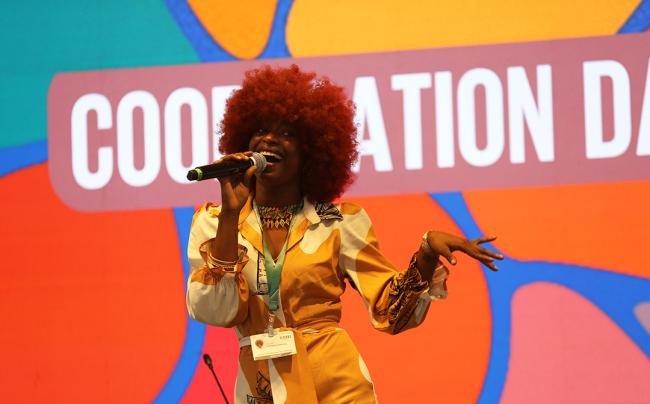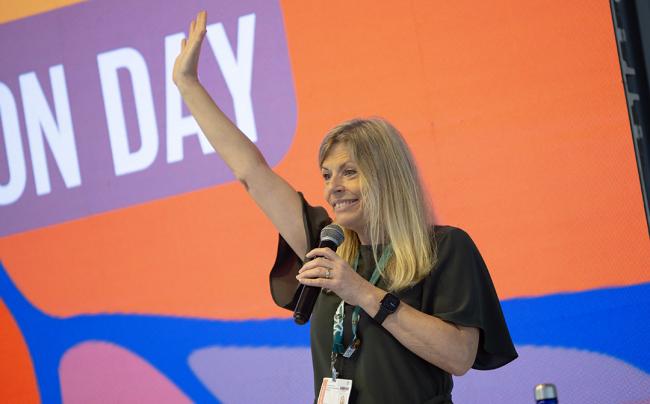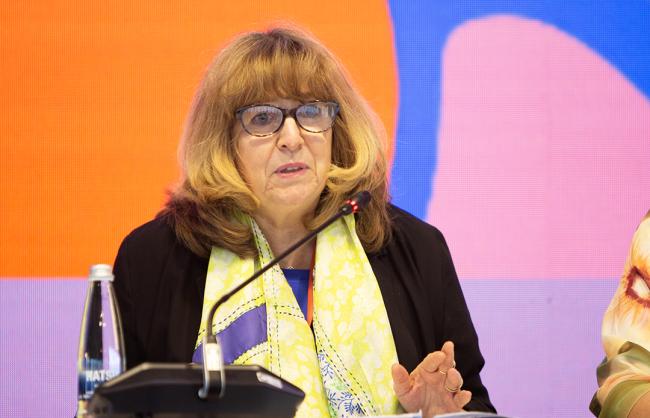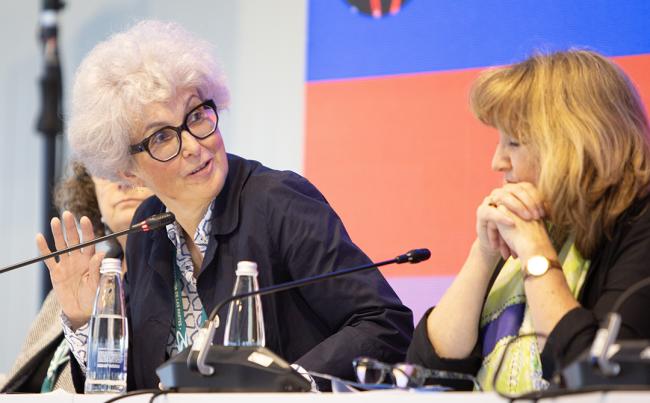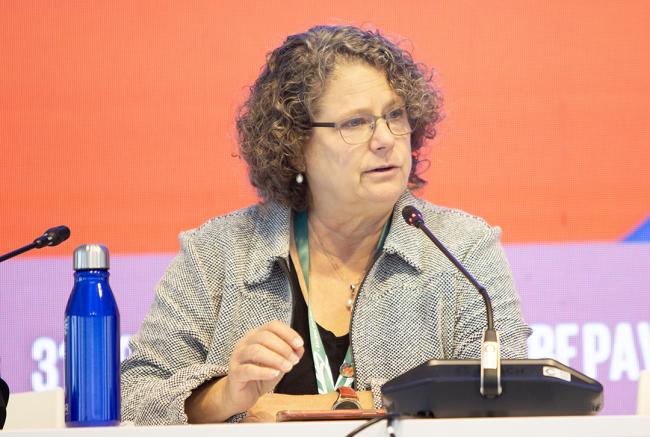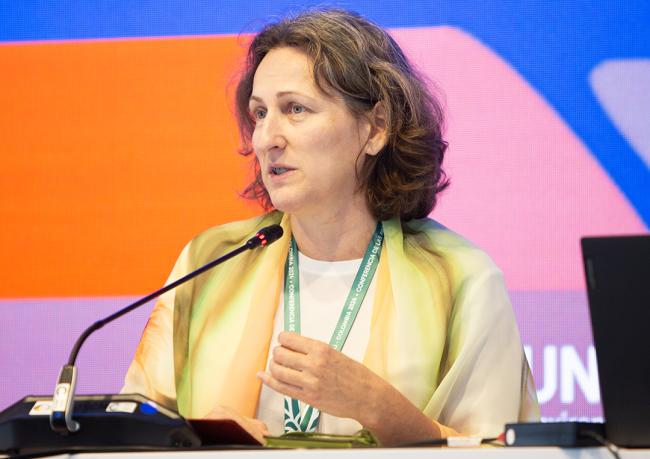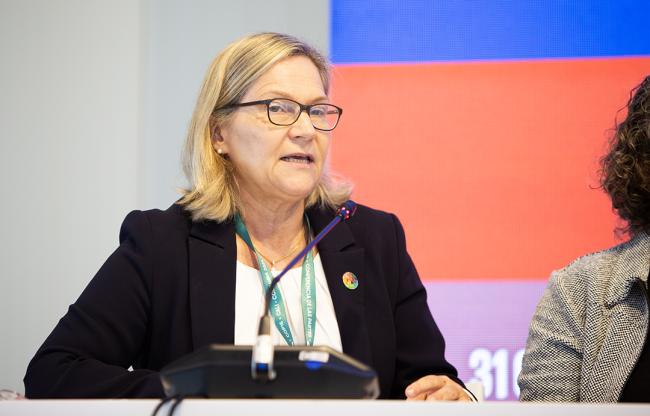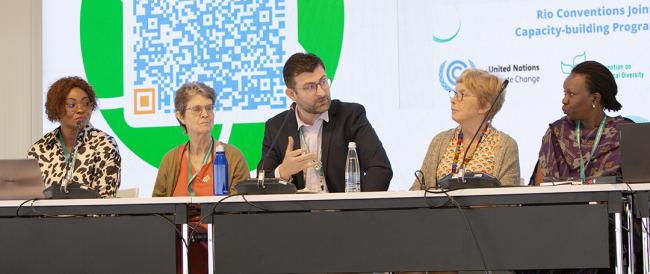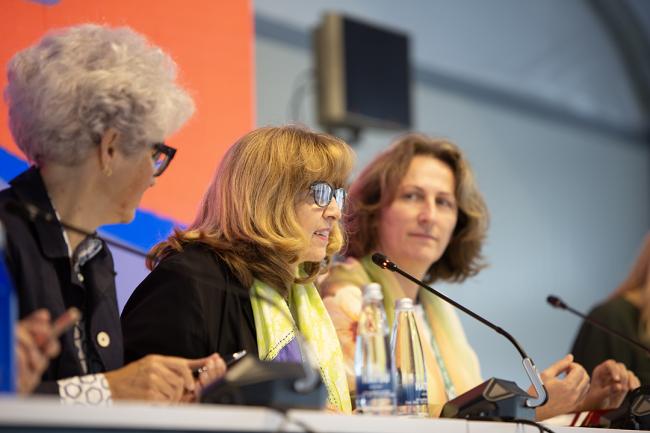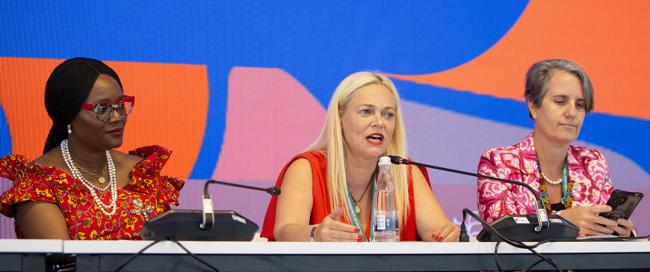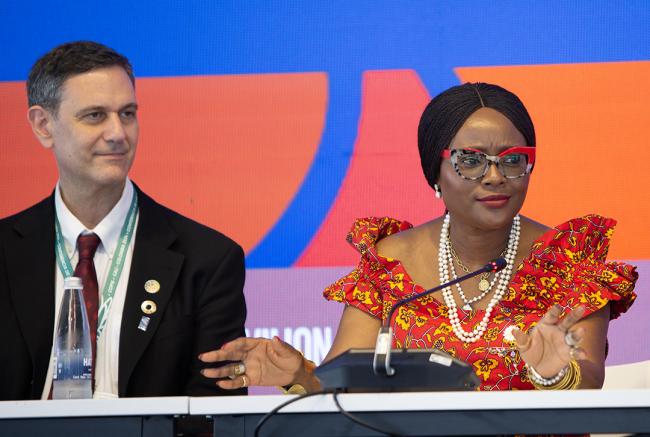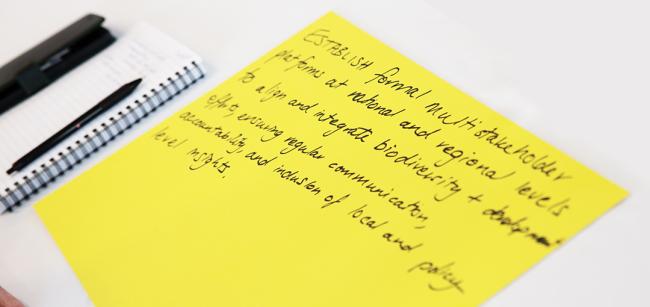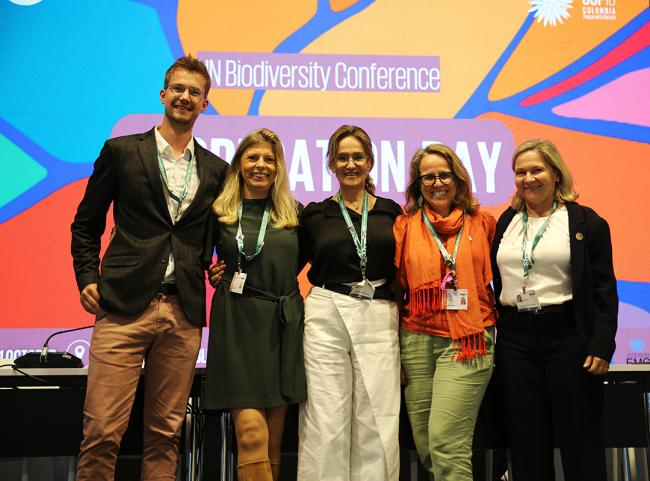About
Highlighting the role of cooperation with different processes, conventions, and multilateral environmental agreements (MEAs) for the efficient and effective implementation of the Kunming Montreal Global Biodiversity Framework (GBF) goals and targets, Cooperation Day provided a space for stakeholders to gather and showcase their cooperation initiatives that were presented and shared throughout the different thematic days of the COP 16.
Stakeholders gathered to discuss how cooperation works in a whole-of-society and whole-of-government approach in integrating global strategies on biodiversity, climate change, land degradation, and pollution.
Natasha Walker moderated the event.
Astrid Schomaker, Executive Secretary, CBD, emphasized that cooperation is key for GBF implementation and for a whole-of-society approach, highlighting the importance of effective participation of Indigenous Peoples and local communities (IPLCs). She noted that despite the diversity of stakeholders and Parties, they all agree on the urgency of addressing biodiversity loss, climate change, and other cross-cutting issues. She urged all to cooperate and act quickly to advance negotiations happening in the plenary.
Katrin Schneeberger, State Secretary and Director, Federal Office for the Environment, Switzerland, highlighted three points for possible synergies: governance; contributions from other MEAs; and reporting burdens.
Amy Fraenkel, Executive Secretary, CMS, noted that even though MEAs have different mandates with specialized and focused work, they still require collaboration through an exchange of knowledge and information to achieve the ambitious goals of the GBF.
Monika Stankiewicz, Executive Secretary, Minamata Convention on Mercury, emphasized the need to include chemical and waste targets in National Biodiversity Strategies and Action Plans (NBSAPs) and highly hazardous chemicals and mercury indicators in the GBF’s monitoring framework.
Tita Korvenoja, UN Environment Programme (UNEP), highlighted UNEP’s role in bringing MEAs together for cooperation and collaboration. She noted that collective action in the UN system and supporting member States in the implementation of national plans is key to GBF implementation.
Experiences on Coherent Implementation of MEAs
Panelists presented case studies on how cooperation is contributing to effective action. Ingrid Coetzee, Local Governments for Sustainability – ICLEI, discussed the whole-of-government approach in national reporting and monitoring. She highlighted the CitiesWithNature and RegionsWithNature Action Platforms, recognized by the CBD for reporting subnational actions and voluntary commitments to the GBF.
Anne Nakafeero, Uganda, noted the cross-cutting and devastating effects of mining, including on human health, occupational hazards, child labor, deforestation, land degradation, and water pollution. She underscored that gold mining, especially artisanal and small-scale mining sites, supports families and the economy. She noted strong political will in Uganda for collaborative efforts on pollution before and accelerated by ratification of the Minamata Convention.
Anne Teller, the EU, spoke on aligning indicators with global MEA frameworks. She shared that following the establishment of the UAE-Belém Work Programme on Indicators under the Paris Agreement of the UN Framework Convention on Climate Change (UNFCCC), climate colleagues reached out to learn from her experience with the CBD’s Ad Hoc Technical Expert Group on Indicators. Teller emphasized the EU’s efforts to create global knowledge support services and the need for informal spaces for information sharing.
Ruth Spencer, Marine Ecosystem Protected Area (MEPA) Trust, underscored the role of community-based actions in achieving global targets. She gave several examples of building connections at the local level, and emphasized how much of local action entails voluntary work.
Ludwig Liagre, Rio Impact, shared insights from the Rio Conventions Joint Capacity Building Programme. He highlighted that a country like Uganda could save up to USD 44 million by enhancing synergies among the Rio Conventions, thus underscoring the importance of resource efficiency over quantity.
Joséphine Thérèse Eloundou, Cameroon, discussed cooperation supporting actions and tools, such as the Bern III Conference on Cooperation among Biodiversity-related Conventions and the Data Reporting Tool for MEAs (DaRT). She shared that Cameroon, to facilitate synergies, created a National Committee on Biodiversity, which includes focal points from all MEAs and different ministries.
Panelists then shared their reflections on these case studies. Hiba Al Shehhi, United Arab Emirates (UAE), highlighted stakeholder consultations across scales, starting from negotiations. She provided an example of their international cooperation, citing a project with Indonesia to create a vehicle of like-minded countries to save the mangroves. She said they are building an international center for scientists to share knowledge and data on mangroves to the global community of scientists.
Ophelia Mensah Hayford, Minister of Environment, Science, Technology and Innovation, Ghana, said her ministry ensures the facilitation of MEAs for the purpose of preserving biodiversity. She underscored the importance of learning through cooperation, technology transfer, and sharing best practices.
Clarisse Kehler Siebert, Co-Chair Bern III Conference, said a space is needed for Parties to come together and engage in discussions because different systems use different languages. She explained that it becomes easier to talk past each other when one is deeply involved in their own focused area. She noted this requires hard work, but in the long-term would save time and money.
Ivonne Higuero, Secretary General, Convention on International Trade in Endangered Species of Wild Fauna and Flora (CITES), highlighted the need to include MEAs and programmatic organizations, such as the Food and Agriculture Organization of the UN (FAO), that have common objectives, to seek complementarity and cooperation. She also underscored the importance of rewarding and incentivizing this behavior and monitoring our own indicators for our cooperative efforts. In addition, she reflected that the perception that cooperating with others will reduce funds for their own projects hinders collaboration.
Christian Schwarzer, Co-Founder, Global Youth Biodiversity Network (GYBN), brought attention to the role of youth in GBF implementation, stating they have relentless passion and drive to create change.
Nakul Chettri, International Centre for Integrated Mountain Development (ICIMOD), talked about the need to support countries to address regional issues. He said drivers of change and biodiversity are regional in nature which requires more development capacity and robust science support systems.
Lu Ning, Ministry of Ecology and Environment, China, shared some projects China has supported in cooperation with different countries – such as the NBSAP Accelerator Partnership and the Nature Champion Initiative – as examples of concrete ways to support implementation of the GBF.
Fostering Synergies at All Levels to Deliver on the GBF
Musonda Mumba, Secretary General, Ramsar Convention on Wetlands, provided a wake-up call, underscoring the high level of degradation that humanity is facing. She noted that communities are often the first to witness the effects of biodiversity loss and are already integrating climate and environmental efforts at all levels. In her call to action, she stated, “change begins with us in this room.”
Farid Hossein Fadaei, Head, Secretariat of the UN Environmental Management Group (EMG), provided an overview of the UN Common Approach to Biodiversity, which seeks to align GBF targets and goals with the mandate of 52 UN agencies and organizations to realize “a culture of nature” in all UN institutions.
Impulses for the UN Common Approach
Cristina Romanelli, World Health Organization (WHO), emphasized strong connections between human health and environmental conservation, expressing frustration with the slow progress of health-related negotiations at the CBD. She pointed to the OneHealth approach as a model for the integrated, whole-of-society strategy needed for effective GBF implementation.
Saskia Carusi, UN Office for Disaster Risk Reduction (UNDRR), highlighted that disasters negatively impact biodiversity, while healthy environments enhance community resilience. She provided examples of UNDRR efforts to help countries integrate disaster risk considerations into climate and biodiversity policies, such as adapting to climate change to mitigate disaster risk.
Benjamin Schachter, UN Office of the High Commissioner for Human Rights (OHCHR), argued that a rights-based approach is the core of a common approach. He expressed frustration with current resource mobilization negotiations excluding observers, highlighting that meaningful participation is key to good decision-making.
Tim Scott, UN Development Programme (UNDP), shared examples of a common approach across governance levels, including: the Taskforce on Nature-related Financial Disclosures, the Climate and Biodiversity Initiative, and the Global Environment Facility (GEF) Small Grants Program.
Kelly Guevara, UN Children's Fund (UNICEF), emphasized that children have been largely absent from CBD COPs. Guevara urged countries to support the efforts of children and youth in advocating for a clean and healthy environment for everyone’s future.
Conversation on Opportunities and Challenges for the Common Approach at the Country and Sub-regional/Regional Levels
Marianella Feoli, Executive Director, Fundecooperacion for Sustainable Development, Costa Rica, highlighted the importance of translating global perspectives to local actions and said that a programmatic approach should be adopted to consider more than the results and focus on the impact of the whole process.
Camila Zepeda Lizama, Mexico, Co-Chair Bern III Conference, shared that a human-rights based approach should not have to be renegotiated under any convention as human rights are non-negotiable. She also shared that the Bern Process has been recreated in Mexico, where various ministries and local focal points for biodiversity have been invited for discussions. She hoped that an interministerial body can be created to keep track of all biodiversity goals.
Interactive Session: Identifying Successes and Challenges of Cooperation and Further Collaboration, Summary and Next steps
Marcos Athias Neto, Assistant Secretary General and Director, Bureau for Policy and Programme Support, UNDP, noted with enthusiasm recent decisions on synergies at the global level. He said we cannot synergize money, and that finances need to be topped up instead. He also cited a huge opportunity to make sure that every dollar, regardless of source, delivers for multiple impact.
Session on Contributions from Thematic and Stakeholder “Days”
David Ainsworth, CBD, said COP 16 was the first time the CBD COP had a “Days” Pavillion, and that it had exceeded all expectations. He noted cooperation is the theme behind all the “Days.” In a metaphor for cooperation, Ainsworth highlighted that the GBF’s logo is inspired by Voronoi diagrams, which combine nature and math, and represent colorful dispersed fractals that take a beautiful form according to what is going on around them.
Moderator Walker then initiated a lighting-round of perspectives from 10 contributors of each "Day" to summarize their insights.
NBSAP Day: Diego Ochoa, NBSAP Accelerator Partnership, reported on the need to break silos and mainstream biodiversity, especially in the NBSAP process.
Education Day: Ainsworth highlighted that we learn in formal and non-formal ways, which implies cooperation is needed across generations, institutions, time, and space.
Ocean Day and Beyond: Imogen Webster, International Whaling Commission, said the Ocean is a reflection of people, culture, economy, ecosystems, and biodiversity – it acts as the great connector.
Health Day: Romanelli argued a whole-of-society approach must consider the needs of vulnerable populations, and treat health as a cross-cutting issue.
Women Day: Sharon Ruthia, CBD Women’s Caucus, said their key message is a gender-responsive GBF and called to action inclusive collaboration among major stakeholders.
NGO Perspectives from the Grassroots Level: Nele Marien, CBD Alliance, Friends of the Earth, discussed the need for systemic level changes, such as global financial structures, highlighting they damage biodiversity and affect local nature defenders.
Academic and Research Organizations: Piet van de Meer, Ghent University, highlighted that research and science can be used for multiple purposes in furtherance of the objectives of the Convention.
Restoration Day: Bethanie Walder, Executive Director, Society for Ecological Restoration, noted restoration binds all three Rio Conventions together, as well as the GBF targets and goals.
Faith Day: Gopal Patel, CBD faith-based organizations, Bhumi Global, emphasized faith can be a bridge builder, and that we need a mechanism for empathy-based dialogues and that synergies should amplify rather than duplicate.
Attendees broke into groups for a roundtable discussion of the most important actions that can be implemented moving forward in a whole-of-government and whole-of-society approach. Recommendations included: establishing knowledge and technology sharing platforms; mechanisms for acknowledging failures in policies and projects; incentivizing community-government-private sector cooperation; establishing formal multistakeholder platforms; ensuring transparency and accountability at all levels; and organizing in a way that mirrors symbiotic relationships.
Closing Session
Walker asked participants to share their main takeaways from the thematic “Days” experience during COP 16.
Participants shared a number of suggestions, including: adding a similar but more encompassing event as part of the COP; having a Cooperation Day at the beginning of COPs; fostering informal spaces more conducive to dialogue; being more proactive in pursuing cooperation partners; and monitoring whether the outputs from Cooperation Day actually lead to cooperation.
In his closing remarks, Ainsworth said it is clear that the biodiversity community needs to cooperate with other COPs and processes and expressed hope that important conversations can happen at the upcoming climate COP. He thanked the attendees for their valuable participation and looked forward to building on the different themes that emerged during COP 16, that “threads us through time and space,” in preparation for COP 17.
Organizers: UNEP, CBD, UNDP, and EMG
Contact: Diane Klaimi <diane.klaimi@un.org>
More information:
https://www.cbd.int/conferences/2024/parallel-meetings/kmgbf-pavilion-cooperation-day

